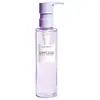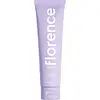What's inside
What's inside
 Key Ingredients
Key Ingredients

 Benefits
Benefits

 Concerns
Concerns

 Ingredients Side-by-side
Ingredients Side-by-side

Water
Skin ConditioningDecyl Glucoside
CleansingCaulerpa Lentillifera Extract
Beta-Glucan
Skin ConditioningSodium Hyaluronate
HumectantVaccinium Angustifolium Fruit
AstringentGlycolic Acid
BufferingLactic Acid
BufferingPhysalis Peruviana Fruit Extract
Skin ConditioningRubus Idaeus Fruit
AstringentArctostaphylos Uva-Ursi Leaf Extract
Skin ConditioningMorus Nigra Fruit Extract
Skin ConditioningVaccinium Myrtillus Fruit Extract
Skin ConditioningScutellaria Baicalensis Root Extract
AstringentPaeonia Suffruticosa Root Extract
Skin ProtectingGlycyrrhiza Glabra Root Extract
BleachingBetaine
HumectantSodium Chloride
MaskingGlycerin
Humectant1,2-Hexanediol
Skin ConditioningButylene Glycol
HumectantParfum
MaskingWater, Decyl Glucoside, Caulerpa Lentillifera Extract, Beta-Glucan, Sodium Hyaluronate, Vaccinium Angustifolium Fruit, Glycolic Acid, Lactic Acid, Physalis Peruviana Fruit Extract, Rubus Idaeus Fruit, Arctostaphylos Uva-Ursi Leaf Extract, Morus Nigra Fruit Extract, Vaccinium Myrtillus Fruit Extract, Scutellaria Baicalensis Root Extract, Paeonia Suffruticosa Root Extract, Glycyrrhiza Glabra Root Extract, Betaine, Sodium Chloride, Glycerin, 1,2-Hexanediol, Butylene Glycol, Parfum
Water
Skin ConditioningSodium Acrylate/Sodium Acryloyldimethyl Taurate Copolymer
Emulsion StabilisingGlycol Stearate
EmollientCetyl Alcohol
EmollientGlycerin
HumectantMalic Acid
BufferingMandelic Acid
AntimicrobialGallic Acid
AntioxidantPanthenol
Skin ConditioningCyanocobalamin
Skin ConditioningAloe Barbadensis Leaf Juice
Skin ConditioningEthylhexylglycerin
Skin ConditioningSalix Alba Bark Extract
AstringentLactic Acid
BufferingGlycolic Acid
BufferingElettaria Cardamomum Seed Extract
PerfumingSantalum Album Wood Extract
PerfumingRose Extract
Skin ConditioningPyrus Malus Fruit Extract
Skin ConditioningChamomilla Recutita Extract
Skin ConditioningSaponaria Officinalis Leaf/Root Extract
Skin ConditioningSalvia Officinalis Leaf Extract
CleansingNasturtium Officinale Extract
PerfumingHedera Helix Leaf Extract
Skin ConditioningFucus Vesiculosus Extract
EmollientCitrus Limon Peel Extract
EmollientArctium Majus Root Extract
Skin ConditioningRubus Idaeus Fruit Extract
AstringentTocopherol
AntioxidantLavandula Angustifolia Flower/Leaf/Stem Extract
MaskingJasminum Officinale Flower/Leaf Extract
MaskingCucumis Sativus Fruit Extract
EmollientCucumis Melo Fruit Extract
Skin ConditioningCitrus Aurantium Dulcis Peel Extract
Emulsion StabilisingCananga Odorata Flower Extract
PerfumingAnthemis Nobilis Flower Extract
MaskingCaprylic/Capric Triglyceride
MaskingDisodium Laureth Sulfosuccinate
CleansingGlyceryl Stearate
EmollientSodium Methyl Cocoyl Taurate
CleansingSodium Cocoyl Isethionate
CleansingCocamidopropyl Betaine
CleansingPhenoxyethanol
PreservativeSodium Benzoate
MaskingPotassium Sorbate
PreservativeCitric Acid
BufferingHydroxycitronellal
PerfumingWater, Sodium Acrylate/Sodium Acryloyldimethyl Taurate Copolymer, Glycol Stearate, Cetyl Alcohol, Glycerin, Malic Acid, Mandelic Acid, Gallic Acid, Panthenol, Cyanocobalamin, Aloe Barbadensis Leaf Juice, Ethylhexylglycerin, Salix Alba Bark Extract, Lactic Acid, Glycolic Acid, Elettaria Cardamomum Seed Extract, Santalum Album Wood Extract, Rose Extract, Pyrus Malus Fruit Extract, Chamomilla Recutita Extract, Saponaria Officinalis Leaf/Root Extract, Salvia Officinalis Leaf Extract, Nasturtium Officinale Extract, Hedera Helix Leaf Extract, Fucus Vesiculosus Extract, Citrus Limon Peel Extract, Arctium Majus Root Extract, Rubus Idaeus Fruit Extract, Tocopherol, Lavandula Angustifolia Flower/Leaf/Stem Extract, Jasminum Officinale Flower/Leaf Extract, Cucumis Sativus Fruit Extract, Cucumis Melo Fruit Extract, Citrus Aurantium Dulcis Peel Extract, Cananga Odorata Flower Extract, Anthemis Nobilis Flower Extract, Caprylic/Capric Triglyceride, Disodium Laureth Sulfosuccinate, Glyceryl Stearate, Sodium Methyl Cocoyl Taurate, Sodium Cocoyl Isethionate, Cocamidopropyl Betaine, Phenoxyethanol, Sodium Benzoate, Potassium Sorbate, Citric Acid, Hydroxycitronellal
 Reviews
Reviews

Ingredients Explained
These ingredients are found in both products.
Ingredients higher up in an ingredient list are typically present in a larger amount.
Glycerin is already naturally found in your skin. It helps moisturize and protect your skin.
A study from 2016 found glycerin to be more effective as a humectant than AHAs and hyaluronic acid.
As a humectant, it helps the skin stay hydrated by pulling moisture to your skin. The low molecular weight of glycerin allows it to pull moisture into the deeper layers of your skin.
Hydrated skin improves your skin barrier; Your skin barrier helps protect against irritants and bacteria.
Glycerin has also been found to have antimicrobial and antiviral properties. Due to these properties, glycerin is often used in wound and burn treatments.
In cosmetics, glycerin is usually derived from plants such as soybean or palm. However, it can also be sourced from animals, such as tallow or animal fat.
This ingredient is organic, colorless, odorless, and non-toxic.
Glycerin is the name for this ingredient in American English. British English uses Glycerol/Glycerine.
Learn more about GlycerinGlycolic Acid is arguably the most famous alpha hydroxy acid (AHA) with tons of research backing its benefits.
It is found naturally in sugar cane but the form used in skincare is usually synthetic for purity and stability.
Glycolic acid removes the top layer of dead skin cells to allow newer and fresher ones to emerge.
AHAs work by breaking down the structural “glue” that holds old skin cells in place. When that buildup is gone, your skin can renew itself more efficiently.
Research also shows glycolic acid stimulates collagen production, helping to firm and thicken the skin over time. This is one of its biggest advantages over other AHAs.
Overall, glycolic acid helps with:
Fun fact: Glycolic acid boosts skin hydration by helping it produce molecules that increase hyaluronic acid naturally.
To work best, glycolic acid products should have a pH between 3-4 (that’s where exfoliation is most effective but still gentle on skin).
The pH and concentration of a product are key to its effectiveness:
It is normal to feel a slight stinging sensation when using glycolic acid. This usually fades as your skin adjusts.
Because glycolic acid has the smallest molecular size in the AHA family, it can penetrate deeper, which enhances its effectiveness but also makes it more likely to irritate sensitive skin.
If your skin is very sensitive or prone to rosacea, glycolic acid may be too strong; in that case, try milder options like lactic acid or a PHA instead.
Recent studies suggest glycolic acid might even help protect against UV damage. But don’t skip sunscreen! Freshly exfoliated skin is more sensitive to the sun.
Glycolic acid is a skincare superstar. It smooths, brightens, hydrates, and firms the skin. Unless you’re highly sensitive, it’s well worth adding to your routine.
Read more about some other popular AHA's here:
Learn more about Glycolic AcidLactic Acid is another well-loved alpha hydroxy acid (AHA). It is gentler than glycolic acid but still highly effective.
Its main role is to exfoliate the surface of the skin by loosening the “glue” that holds dead skin cells together. Shedding those old cells leads to smoother, softer, and more even-toned skin.
Because lactic acid molecules are larger than glycolic acid, they don’t penetrate as deeply. This means they’re less likely to sting or irritate, making it a great choice for beginners or those with sensitive skin.
Like glycolic acid, it can:
Lactic acid also acts as a humectant (like hyaluronic acid). It can draw water into the skin to improve hydration and also plays a role in the skin's natural moisturizing factor (NMF) in the form of sodium lactate.
Studies show it can boost ceramide production to strengthen the skin barrier and even help balance the skin’s microbiome.
To get results, choose products with a pH between 3-4.
Lower strengths (5-12%) focus on surface exfoliation; higher strengths (12% and up) can reach deeper in the dermis (deeper, supportive layer) to improve skin texture and firmness over time.
Though it was originally derived from milk, most modern lactic acid used in skincare is vegan. It is made through non-dairy fermentation to create a bio-identical and stable form suitable for all formulations.
When lactic acid shows up near the end of an ingredient list, it usually means the brand added just a tiny amount to adjust the product’s pH.
Legend has it that Cleopatra used to bathe in sour milk to help reduce wrinkles.
Lactic acid is truly a gentle multitasker: it exfoliates, hydrates, strengthens, and brightens. It's a great ingredient for giving your skin a smooth, glowing, and healthy look without the harshness of stronger acids.
Read more about some other popular AHA's here:
Learn more about Lactic AcidWater. It's the most common cosmetic ingredient of all. You'll usually see it at the top of ingredient lists, meaning that it makes up the largest part of the product.
So why is it so popular? Water most often acts as a solvent - this means that it helps dissolve other ingredients into the formulation.
You'll also recognize water as that liquid we all need to stay alive. If you see this, drink a glass of water. Stay hydrated!
Learn more about Water